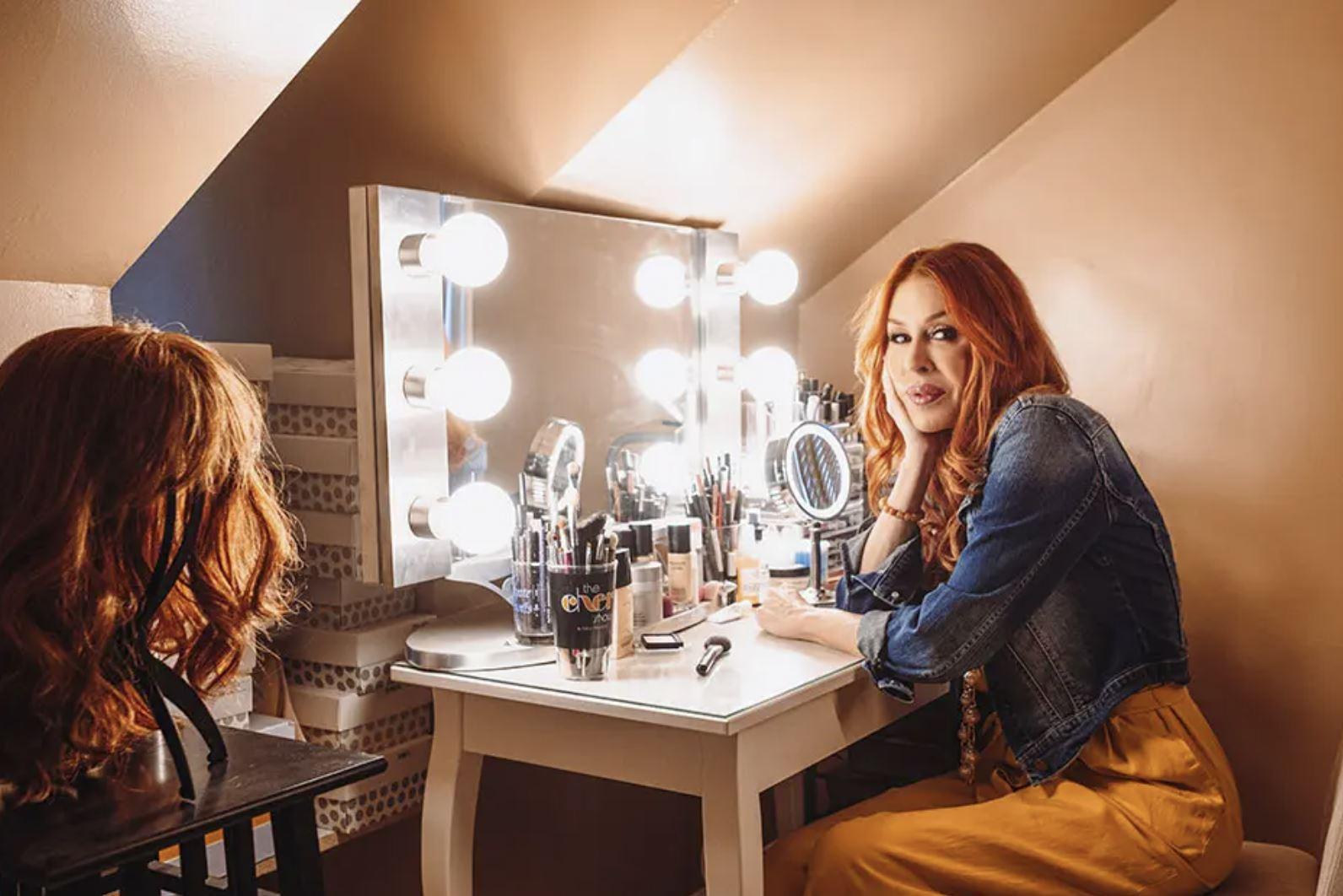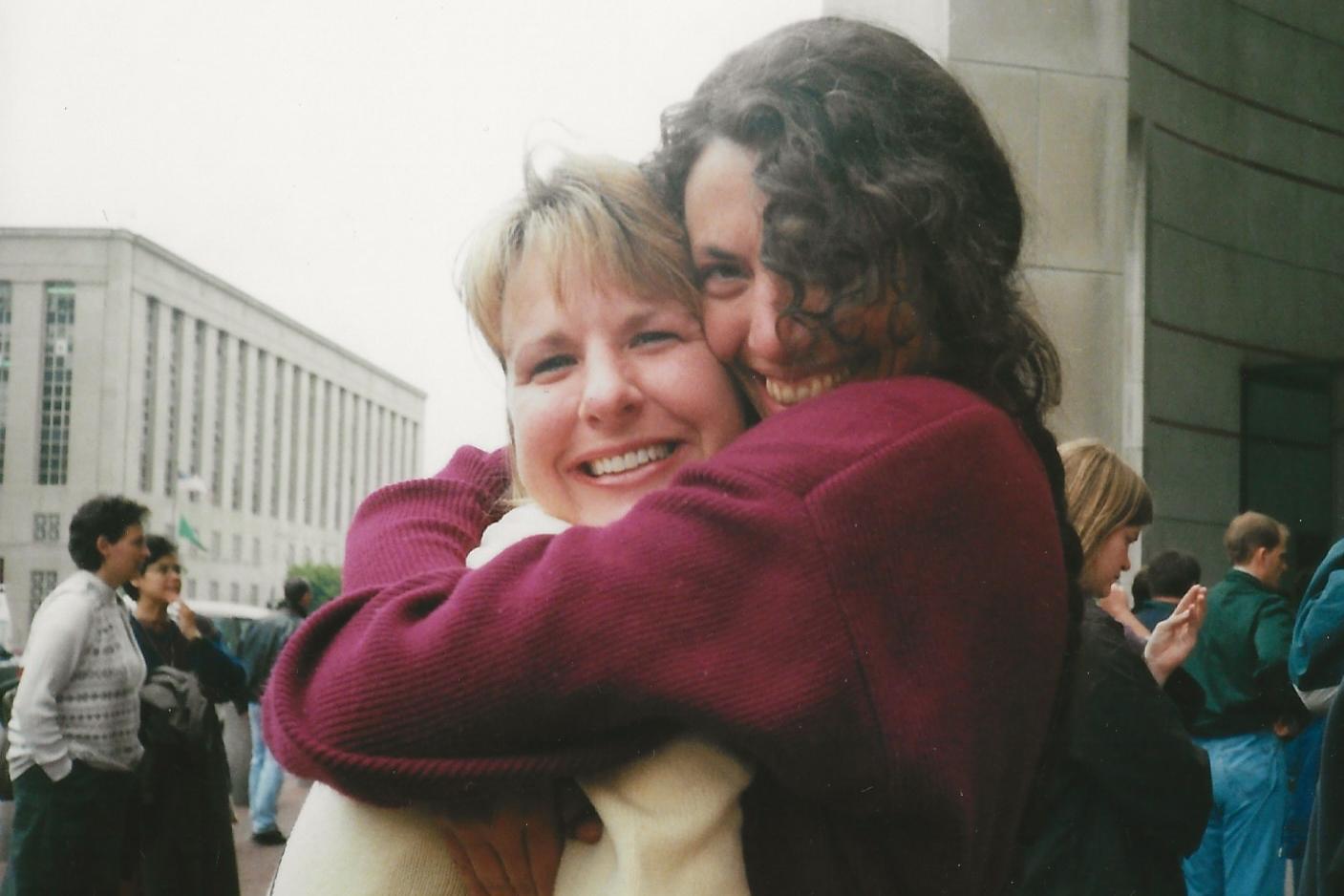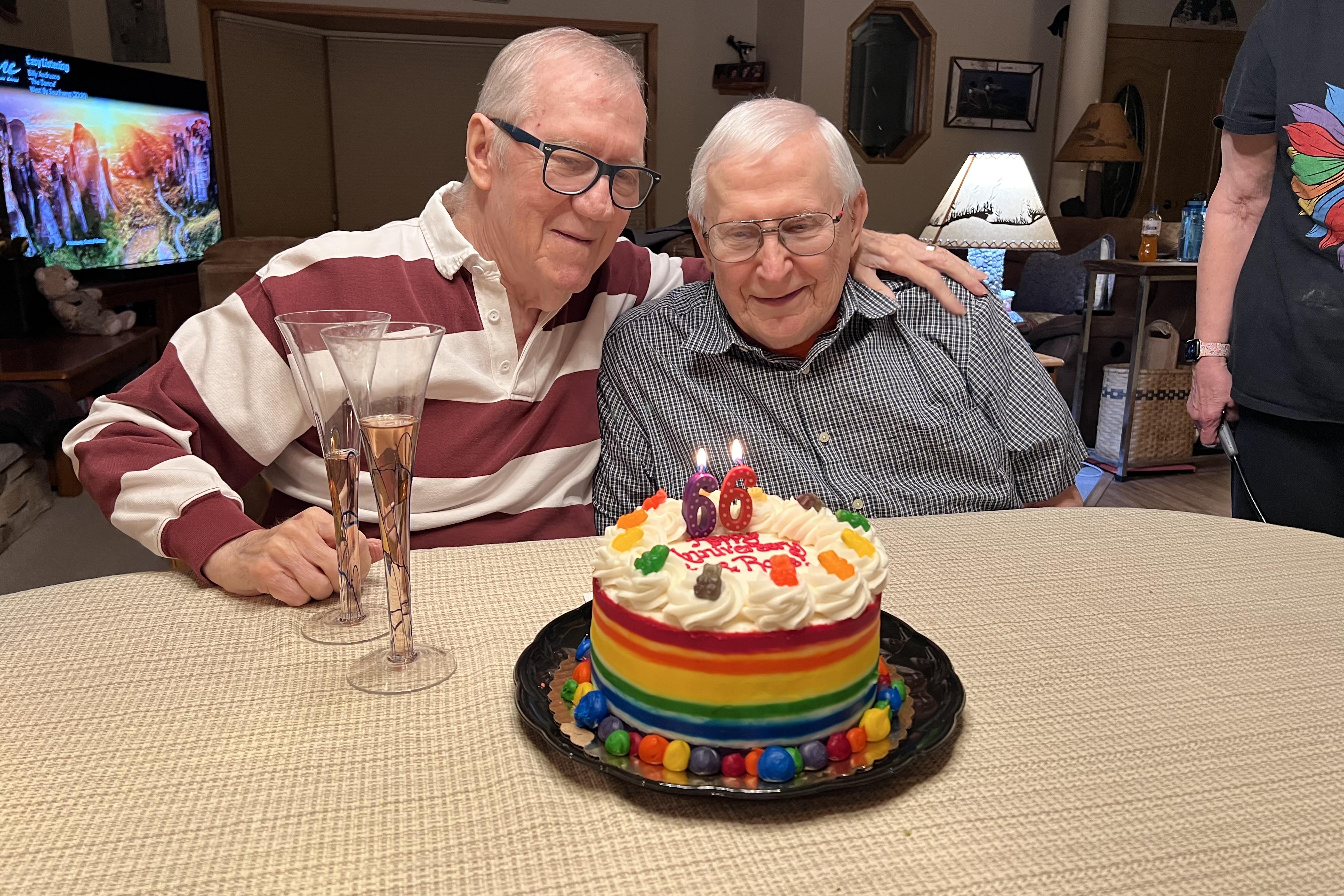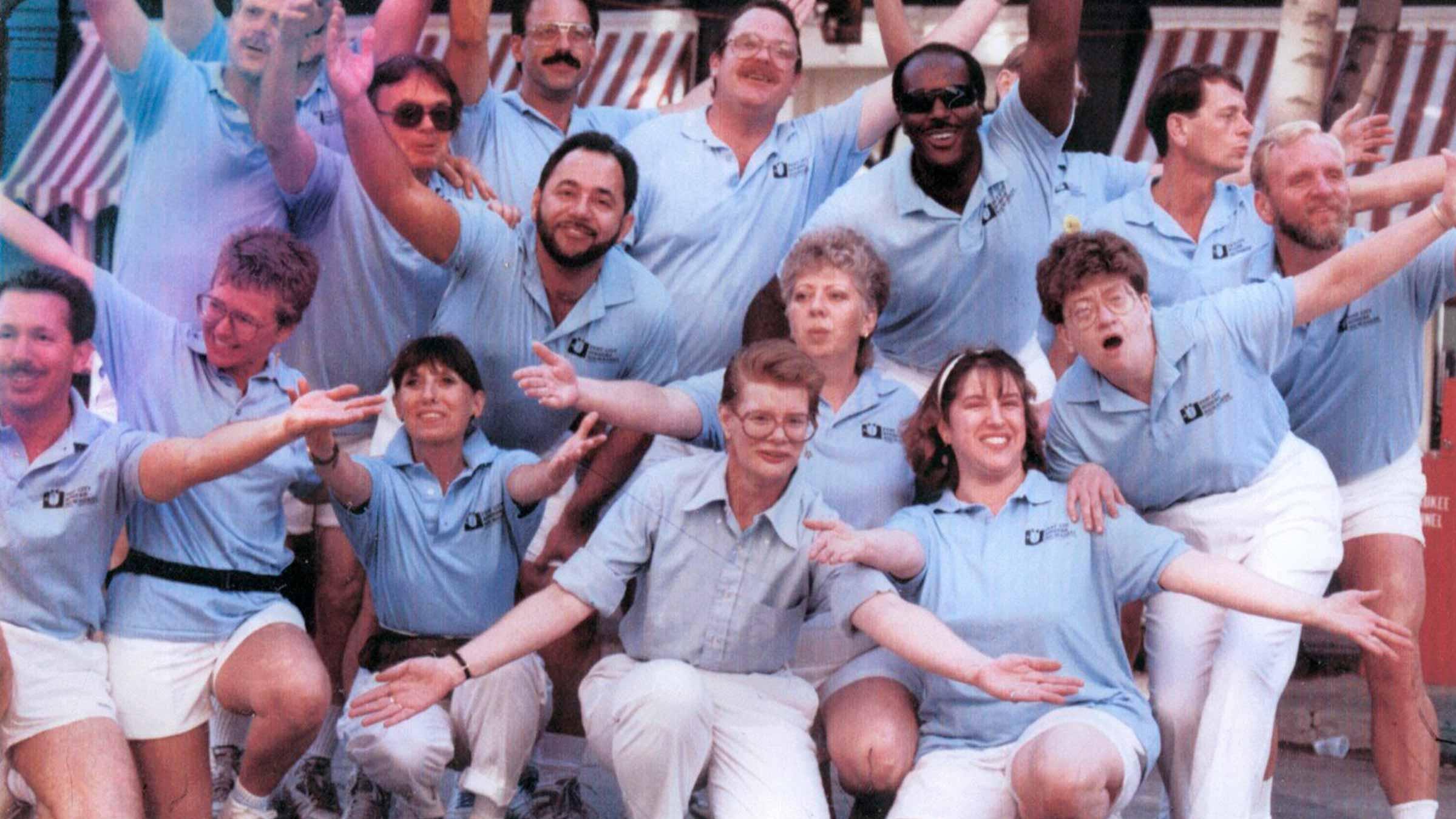
Candi Stratton: confronting the hidden dangers of body work

From the moment she could talk, Candi identified as a girl. She didn’t know anything about being “trans,” but after seeing her first drag show in Chicago in 1981, she knew immediately that she had to do it.
“The queen was a Diana Ross impersonator,” she explains. “Somehow, he really looked like Diana Ross. It was the true meaning of glamour. I felt like a spell had been cast on me. I was so completely drawn into this world.”
Soon, Candi Slice was performing at La Cage (50 E. Oak Street in Chicago) then billed as “the most excellent female impersonators in the City of Chicago.” The bar is remembered for its grand opening in 1980—“an explosion of pink feathers”—and its pink Baby Grand piano. She joined the last great cast of La Cage, including Shante, Ginger Spice, Patti Cakes, and Lisa Eden.
La Cage had no stage, so performers delivered their numbers out in the audience. This worked especially well for Divine, who began her national nightclub circuit here with a weeklong run. The space had previously been owned by actress Barbara Eden, who visited La Cage once while Candi was working.
“I’ll never forget the first trans girl I ever saw,” said Candi. “Some gay friends leaned over, while she was performing, and whispered to me ‘that’s a man.’ My mouth hit the ground—not because of what they said, but because I knew right there and then, I wanted to be that. I will never forget that moment.“For me, the drag world was my chance to express my feminine side,” said Candi. “I didn’t know anything about transitioning at all. I was still living at home. My parents didn’t know what I was doing. All they knew is that I was taking dance classes in downtown Chicago.
The high cost of being beautiful
Female feminization surgery wasn’t offered anywhere when Candi transitioned in the early 1980s. Trans women usually had access to rhinoplasties (i.e., nose jobs) and silicon injections to adjust their facial appearance. These treatments were designed to make them softer, rounder, slightly plumper, and they were considered essentials.
While doing drag in Chicago, Candi was introduced to someone who offered silicon injections to the performers. She was only 19 years old and very trusting of what she was told. Even so, something about the injection procedure just didn’t seem right—even 40 years ago.
“We went into her office for my first treatment,” said Candi, “and she had the ‘silicon’ in this big, uncovered fishbowl on her desk. As she filled up the needle, I remember thinking to myself, ‘Oh God. Oh God. That is going into my face?’”
While planning for a pageant, Candi received her second injection from a world-renowned New York City doctor.
“This time, it was much more formal,” said Candi. “I had to make an appointment, discuss my medical history, and sign about a dozen documents saying I wouldn’t sue him.” The doctor assessed Candi’s first injection and came back with a troubling comment.
“I don’t know what’s in there, but it’s not silicon,” he said. “It might be whale oil.”
Somehow, the comment got back to the first provider, and she was furious with Candi. It didn’t matter so much to her at the time, as she’d already found a safer and more reliable doctor—or so she thought.
“My second treatment with him covered my cheeks and chin,” said Candi. “Eventually, I had 10 treatments on my face. I never did a nose job, just the silicon. It was $150 per facial injection.”
Facial work was only the beginning. Body work, such as breast or hip injections, cost $300 per injection. Some girls would opt for double or triple injections to accelerate the transition.
“I remember a nurse who used to do body work,” said Candi. “She used to work for a plastic surgeon. People would say, ‘Hey, she’s not cheap, but at least she’s using medical grade silicone.’ She traveled around the world pumping girls full of silicone. She did my hips and one silicon treatment in my breasts. Instead of more silicon, I got implants with my New York City doctor. So that one silicon treatment was the only one she ever did.'
“Nobody knew back then what we know now,” said Candi. “There weren’t any wise trans elders telling us what was going to happen to our bodies. There wasn’t any trans helpline to tell us what to do or not do. Nobody knew what would happen years later."
"The worst part was, the girls who referred me got a kickback for my purchases. They either got free or reduced services every time they brought someone new in. I was offered a kickback if I referred someone. And so it goes, on and on, and nobody wants to break the circle and lose their fix. Instead, the circle just keeps getting bigger and bigger, increasing the risk of serious medical harm to more and more women.”
Nearly deadly detours
Overall, the silicone injections worked fine for Candi. Until they started turning.
“I’d gotten a little dent,” said Candi, “and so I had her do a little filler to fix the dent. The dent turned dark on me. Well, I found out that she was using furniture grade silicone, which contains formaldehyde, and is not safe for any human consumption!"
“Here she was, pumping patients with HIV, patients with full-blown AIDS, claiming she was putting life, color, and fullness back into them. Their bodies are already fighting a dread disease, and they’re being pumped full of something that will harm them even more."
“We got into a fight. ‘How dare you?’ I yelled. ‘How dare you!’
“You just don’t know what you’re going to get. They say, ‘Oh, it’s medical grade,’ but let me tell you, Honey. I lived in Thailand and worked in a hospital. I saw what real medical grade silicone looks like, and it doesn’t come in a vat, a tub, or a fishbowl! It comes in a tiny vial. Anyone who tells you they’re working with ‘medical grade’ is lying to you.”
Despite the facial dent, Candi’s body work looked great for years. And then she turned 48.
“I got a nodule on my face,” said Candi, “and then my hips started noduling, with these little lumps and bumps. I was really concerned about having orthopedic surgery, especially in both hips. I hadn’t told my doctor I was trans, although everyone was telling me I should."
"Finally, I came out with my mom in the room with me. He responded, ‘Well, I’m here to do a service, and my personal opinions don’t come to work. I’m here to make sure you get better.’ What a relief!
"After the surgery, he told me that he encountered the silicon during the incision process, and that it was crystallized with scar tissue accumulating around it. My right hip had a really hard time healing after surgery, and oily, yellow silicone fluid was constantly leaking out. The wound finally closed after a very long time.”
Following her mother’s medical issues, Candi surrendered to emotional eating that led to significant weight gain and a prediabetes diagnosis. This was devastating news to Candi, who saw her father live with the highs and lows of diabetes after age 45. After being advised she needed to gain more weight to qualify for surgical weight loss benefits—“the miracles of the American healthcare system,” she laughs—she elected to pay out of pocket to have gastric sleeve surgery in Mexico.
After losing so much weight, Candi noticed more surprising changes to her body.
“The silicone in my hips fell, and looked like McGriddles stuck to each side,” she said. “So embarrassing! I knew I needed to get those out. And my face really fell. There were big lumps everywhere on my face. The silicone looked so heavy. I decided to get a mid-face facelift.”
Candi consulted with the well-known Dr. Lazaro Cardenas in Guadalajara, Mexico on next steps.
“The doctor was completely honest with me: once you pump that in, it’s hard to get out,” said Candi. “I couldn’t have been happier to find someone so honest, ethical, and trustworthy. And it really got me thinking and researching the extent of this problem.”
 Candi Stratton (by Diana Mixalakapoulos)
Candi Stratton (by Diana Mixalakapoulos)
“It won’t happen to us.”
It’s not just trans women and drag queens who’ve fallen victim to unsafe and unprofessional body work.
The “filler party” trend has led cisgender women to receive bargain basement treatments in hotel rooms and emerge looking like 1980s trans women. Cis and trans men alike rely on silicone for pec implants, striking cheekbones and masculine jawlines. Girls as young as 13, with parental consent, are showcasing questionable injections on Instagram and TikTok
In response, silicone removal services are advertising on social media around the world.
“Silicone can sit in your face for years,” said Candi, “but someday it will start rejecting it. Count on it. It’s inevitable."
"Today, you’ll see these drag pageant contestants with such uneven, lumpy silicone, and sometimes you’ll actually remember this isn’t normal,” Candi said. “One girl told me, ‘I’m Egyptian, I only had one treatment, and the rest is all natural.’ As a flight attendant, I’ve been to Egypt, and nobody looks like that!"
“We’ve just gotten so used to seeing ‘that look.’ We just say she looks fabulous—and we move on to the next one. The big hips. The little waist. Breasts as hard as boulders. The uneven, lumpy texture of it all. What we should be saying is, ‘Girls, stop doing this!’”
Candi points to the life-threatening risks of silicone toxicity.
“There are girls who’ve actually died from bad injections,” said Candi. “Scar tissue builds up and causes horrible circulation problems. If this gets into your lungs, the fluid can build up like pneumonia, and they cannot get it out. If this gets into your bloodstream, you will die faster than a stroke. Don’t think I wasn’t scared while getting my hips replaced that this might happen to me."
“Don’t fall victim to Instagram,” said Candi. “Don’t fall victim to the illusion of a fully filtered life. Do your research. Body work may be cheap now, but it will be very expensive later on. I’m living proof."
“The younger kids say, ‘It’ll never happen to me. I’ll be fine,’” said Candi. “They are directed within their house families to get this done, often as a rite of passage, as a show of commitment to their new self. They’re either pushed into it or walked into it themselves. They choose the quick fixes, even though they know what might happen to them. Some girls just don’t want to hear it."
“My message is this: Just don’t. Do NOT. There is now facial feminization surgery. There are now trans-affirming medical benefits available at many major companies. They will cover everything from electrolysis to FFS to voice. They will reallocate natural fats within your own body to supplement your transition."
“When I was transitioning, you couldn’t even find a trans girl working in a major department store,” said Candi. “Not even in cosmetics. Girls today have a lot more options than they do back in the day. There is more available to you than sex work or drag work."
“Nowadays, if you want it, you can get it, and many of the nation’s largest employers offer trans-inclusive health insurance. Starbucks. T-mobile. Even McDonalds! They’ll pay you, school you, and insure you while you better yourself. Please consider this route before going the quick and easy route."
“I’m very open about my whole journey,” said Candi. “I’ve video blogged on Instagram and Facebook—both my personal and professional accounts. I’ve been honest. I want to help as many as I can.”
Candi recognizes that, for many trans women, the last thing they want and need to hear is someone telling them not to pursue the transformation they’ve waited their whole lives to achieve. She knows how hypocritical it might feel for someone to deny others the choices they made for themselves.
“I’m not telling anyone what to do, or what not to do,” said Candi. “I don’t care what anyone else tells you. Just remember this. If you think it’s not going to happen to you, think again.”
Candi finds her calling
Although she still lived in Chicago, Candi spent a lot of her time in Milwaukee, working at Club 219 and sharing memorable moments with the Club 219 Girls.
“Milwaukee was a magical place for me,” she said. “We were young, and frivolous, and carefree, but we were very hard on ourselves at the same time."
“I loved working at 219,” said Candi. “I loved performing on that stage, hovering high above everyone. The girls were all so creative—and there was no better show in town than ours. That’s what people came to see: real productions with an opening, middle, and closing sequence. I was working during the week at La Cage in Chicago, and on Sundays at Club 219 in Milwaukee. I really don’t know how I kept up that pace!"
“Tony and Del treated us all so great. Back then, it was Ginger Spice, B.J. Daniels, Gloria P. Hole, Abbey Rhodes, Patti Cakes. I was Candi Slice, a ‘little slice of heaven,’ until a promoter told me that he’d never crown Candi Slice. Soon afterwards, I saw Star 80 and seriously felt that I was Dorothy Stratton reincarnated. That’s when I became Candi Stratton."
“I was a professional dancer and wanted to be a cheerleader growing up so badly. I practiced and practiced until I could do jumps and splits better than anyone. In fact, I could do 20 spread eagle jumps in a row!"
“MTV had just started,” said Candi, “and drag hadn’t really caught up with it yet. I remember seeing drag shows where everyone just came out and did their own torch song. I remember thinking, ‘Please, someone, do something exciting, or I’ll slit my wrists.’ There was no energy, no vibe. It was like a night at the opera. It was so boring!"
“I was a little kid from the suburbs, but I knew I could do better,” said Candi. “La Cage said I would perform two weeks for free as my audition. If they didn’t like me, I would leave. If they did like me, I would stay and they would hire me. Well, I went out there and danced the whole house down. The crowd went crazy. They’d never seen anything like this before. And I got hired!"
“I would try to copy MTV, which had a greater influence on drag that we could ever have imagined. Olivia Newton John “Physical,” Laura Branigan “Gloria,” Pat Benatar “Hit Me With Your Best Shot,” Irene Cara “What A Feeling,” and of course Toni Basil’s “Mickey” which became my theme song. At one point during my signature number, I would jump up in the air, do the splits, and land in that position. The crowd would scream!” said Candi.
Candi won Miss Continental Wisconsin at age 23. It was the first pageant held at the Milwaukee Performing Arts Center, and the community came out for it.
“The stage, the runway, they were both so enormous,” said Candi. “Pageants were fabulous back then—a true event!"
“What are you going to see today? Just a bunch of performers. Just one drag number after another. People clapping to the music and working the room for tips. What happened to the art form? Everyone’s got the same hair. Everyone’s painted the same. Where’s the individuality?"
“I remember La Cage being super busy,” said Candi. “We were popular enough to be featured on the Phil Donahue show. Everything seemed to be going great—and then the IRS shut us down in 1983.”
Paula finds her voice
Three months after her gender affirmation surgery, Candi Stratton aka Paula Randall became a flight attendant.
“At that time, you wouldn’t be hired if you were trans,” said Candi. “I always tell people I face my fears. I never let them hold me back. If I did let them hold me back, I’d never have gone through that interview or connected with my dreams."
“I was honest with the first person I interviewed with. They pushed me through because they believed in me. They said, ‘Now you just have to complete the physical examination and the training.’ This was a full hospital gown physical. I said, ‘Great, what does the exam consist of?’ They called the medical center to find out. Thirty seconds later, on speakerphone, someone is asking ‘Do you want to hire this person? Because you know, we don’t hire those people. We steer clear of those people.’ This is the late 1980s! My hiring manager said, ‘She’s attractive, she’s reliable, and she has a great personality. Yes, I want to hire her.’"
“From that day, to now, American Airlines has done a complete 180 degree change. They were the first airline to have an employee pride committee in the early 1990s. They’ve done so much for the trans and gay communities. But it was a long road to here. A lot of airlines didn’t hire you if you were trans, and if you transitioned after getting hired, it was nearly impossible to keep your job. If you had a supervisor who didn’t like you, or understand your identity, they’d still get rid of you."
“So, I lived a double life in stealth mode: Paula was my work identity, and Candi was my outspoken trans advocate identity. And that’s how I lived for 30 years!”
 Candi Stratton (by Tios Photography)
Candi Stratton (by Tios Photography)
Overseas -- and back again
After living in Australia for seven years, Candi was recruited to move to Thailand to work as an on-air personality for a local talk show. She accepted a job as a PR person for Bed Supperclub and hosted an evening at the club. And then, she was asked to be an international ambassador.
“Yanhee Hospital is a large, 24-hour hospital in Bangkok that specializes in cosmetic surgeries,” said Candi. “They asked me to be a spokesperson for their plastic surgery program for a year. Bangkok is so cosmopolitan and so fashionable, and I enjoyed the people of Thailand so much, but it’s an entirely different life.”
Candi’s parents had retired to the Quad Cities in 1989. Facing hip replacement surgery, Candi chose to move there in 2016 for recovery.
“There’s no way I could have climbed to the fourth floor of my Philadelphia rowhouse,” she said. “My mother was suffering from macular degeneration at the time, and I knew it was time to move closer. I rented a little house and spent a lot of time with mom. After two years, she moved into assisted living."
“I love her, she’s my best friend, but we can’t live together,” said Candi. “I would ask her, ‘What if I would go out and meet someone? What if I wanted to bring a guy home?’ and she’d say, ‘Not at my house, you’re not!’ I loved being a little instigator."
“After two years, she had a stroke, and we moved her into assisted living,” said Candi. “And I decided to stay. My grandparents had lived here, and if you ever told me I would live here, I would have looked at you, laughed at you, and slapped you!”
“I found a storybook home, straight out of Hansel & Gretel. Never have I ever walked into a home and said, ‘I’m in love!’ like I am with this one. Everyone who walks in can feel the same energy. This is the right place for me. It’s got character, charm, and warmth. I’m very happy here.”
Leaving a lasting legacy
The tagline of Miss Trans USA 2019 was “trans visibility.”
This wasn’t lost on Candi, who realized that the time had come to “come out” again—this time, within her workplace. Miss Trans USA was scheduled one day after National Coming Out Day, so she concocted a plan to celebrate her true self.
“Watching kids being so out and vocal has been liberating,” said Candi. “The younger generations are my heroes. They reminded me, ‘Okay Paula, if you’re going to talk the talk, you need to walk the walk.’"
“I created a post of myself being crowned Miss Trans USA 2019, and noted, ‘So last night, this happened.’ And here I thought I’d outed myself. Except, people couldn’t see the sash, so they didn’t know what I’d won!"
“On Monday, I went back and posted again: Friday was National Coming Out Day, and on Saturday I won Miss Trans USA, and I hope you’ll still love me as a human being. I received such an overwhelming, positive reception. I earned a standing ovation when I entered the crew lounge. My story was shared with 130,000 employees worldwide via our employee website. I was able to speak about my experience, which inspired some parents to reach out to me about their own children."
“When I broadcast this message, I shared it on my Paula page also, so I was completely out and honest with both the straight and cis communities,” said Candi.
“What a journey it’s been. I left Candi Stratton on the stage when I had my surgery, and decades later, I started doing shows again. While I was living in Australia, I pulled my Cher act back out of my hat, and it took off crazy. I started receiving booking offerings. This was wild to me: according to the old rules, you weren’t supposed to do drag anymore after your transition. But Cher took off. My social media accounts took off. Suddenly, I was doing pageants again. Never say never—never think you’re done!"
“What’s most important to me is staying vocal on trans issues,” said Candi. “Whether I reach one person, or two, or many, I hope I’ve helped some people. We are human beings with hearts and souls. I hope I’ve changed opinions of who and what we are."
“After all, you can’t say you don’t know a trans person anymore. You know me.”
This article first appeared in the May 2022 issue of Our Lives Magazine.
 Candi Stratton (by Patrick Farabaugh)
Candi Stratton (by Patrick Farabaugh)
recent blog posts
April 06, 2025 | Michail Takach
Camille Farrington & Vicki Shaffer: standing up for students
March 31, 2025 | Amy Luettgen
March 29, 2025 | Michail Takach
The concept for this web site was envisioned by Don Schwamb in 2003, and over the next 15 years, he was the sole researcher, programmer and primary contributor, bearing all costs for hosting the web site personally.




